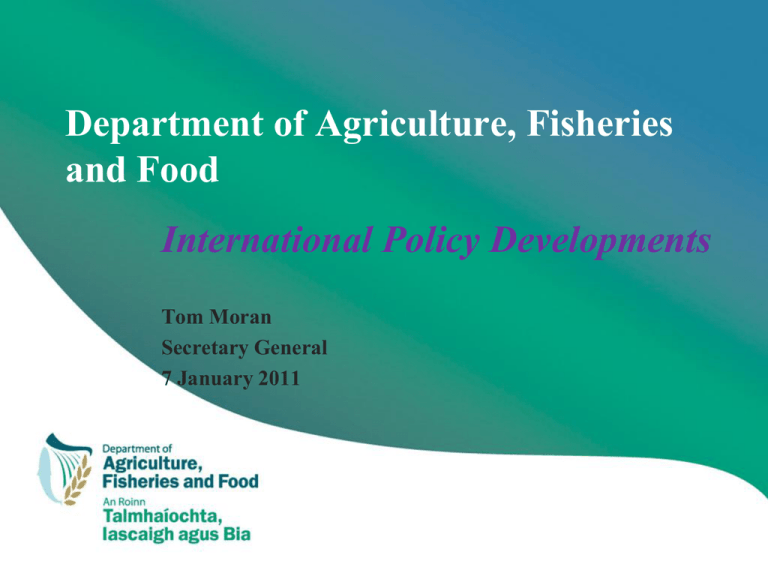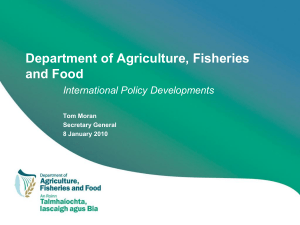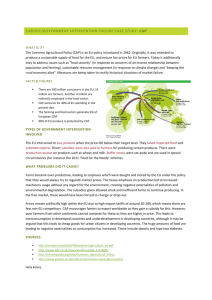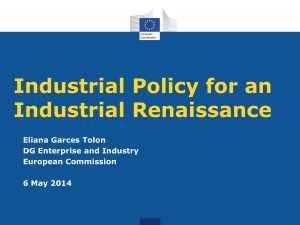Department of Agriculture, Fisheries and Food International Policy Developments Tom Moran
advertisement

Department of Agriculture, Fisheries and Food International Policy Developments Tom Moran Secretary General 7 January 2011 2010 and Beyond • Context / Overview • Food Harvest 2020 • CAP Reform – 2013 + • Mercosur Negotiations • WTO Food Harvest 2020 Industry-led Strategy for Agriculture, Food and Fisheries sector -launched in July 2010 • 217 recommendations to ensure central contribution of agri-food and fishing sector to the export-led economic recovery; full development of the smart economy. Food Harvest 2020 Key Themes SMART + GREEN = GROWTH Food Harvest 2020 Smart Growth •Prioritise and target R & D •Improve skill levels •Maximise adoption of best practice •Foster creativity and entrepreneurship •Rationalise and collaborate at level of farm and industry •Review institutional supports while minimising regulatory costs •Focus on consumer preferences Food Harvest 2020 Green Growth •Prioritise environmental protection •Scientifically validate Ireland's environmental credentials •Complete supply chain focus on sustainability •Achieve international recognition as a producer of environmentally sustainable product •Develop ‘Brand Ireland’ or other mechanisms to differentiate our product offering Food Harvest 2020 Growth Targets •Increase the value of primary output in overall sector by €1.5 billion - 33% increase •Raise the sector’s value-added by 40% from €7.9 to €11 billion. •Exports for the sector to rise to €12 billion - a 42% increase •50% increase in milk production and 20% increase in value of beef production •Value of the seafood sector to increase from €700m to €1 billion including a 78% increase in volume of aquaculture production. •Employment increase between 7,000- 7,500 Food Harvest 2020 - Implementation • High-Level Implementation Committee (HLIC) established to prioritise & drive implementation of FH2020 •Chaired by Minister Smith, comprises CEO of main State Agencies (BB, BIM, EI, Teagasc, EPA) and Depts. • 2 meetings to date, determined actions to be taken on dairy competitiveness, Brand Ireland, research and development and the horticulture sector. •Next meeting on 12 January will analyse Progress on FH 2020 recommendations Dairy Action Committee Roadmap Delivering on potential of aquaculture Progress Reports on Farm Partnerships, Beef Competitiveness, Research and Horticulture. CAP 2013+ Negotiation Process • Initial Council discussions in 2009 / 2010 plus bilateral contacts and informal groups of Member States • Budget review document released October 2010 • Commission communication released November 2010 • Impact analysis in April 2011 • Legislative proposals in mid 2011 • European Parliament Reports: Lyon Report June 2010; Two to follow. • Decisions in 2012 ? (Danish and Cypriot presidencies ) CAP 2013+ Negotiation Process • Initial Council discussions in 2009 / 2010 plus bilateral contacts and informal groups of Member States • Budget review document released October 2010 • Commission communication released November 2010 • Impact analysis in April 2011 • Legislative proposals in mid 2011 • European Parliament Reports: Lyon Report June 2010; Two to follow. • Decisions in 2012 ? (Danish and Cypriot presidencies ) Commission CAP communication Three broad policy options: 1. Minimal change – but “more equity” in distribution of payments 2. Actual Commission proposal 3. Radical change – environmental public good payments only Proposals in Commission communication • Strong, 2 pillar structure with 3 strategic aims – Preserving food production potential (farm incomes & competitiveness). – Sustainable management of resources (public goods, green growth & climate change) – Maintaining viable rural areas (jobs, diversification, structural diversity) • “Greener” pillar 1, with “more equitable” distribution of payments • Rural development (pillar 2) funds distributed on “objective criteria” • Continued market supports at safety net level Single Payment Scheme Issues: distribution of funds between Member States • Distribution of pillar 1 funds between MS: – Communication floats possibility of “a system that limits the gains and losses of Member States by guaranteeing that all farmers in all Member States receive on average a minimum share of the EU-wide average level of direct payments” • Irish view is that any discussion of redistribution must: – Start with the current distribution – Use accurate per hectare basis for comparison (ie eligible area, not UAA) – Recognise that costs of living vary greatly in the EU – Be kept separate from issue of payment models Single Payment Scheme Issues: Payment Models • Distribution of funds between farmers within a member state: – Draft Communication suggests “greening” of direct payments through a layered payment with a basic flat rate and a mandatory green component, with additional support for areas with “specific natural constraints”, and optional limited coupled support. • Irish view is that there should be flexibility on payment model at Member State level: – Agro-ecological conditions vary hugely within EU – So does the socio-economic structure of farming – The political debate about the CAP and justification for payments also vary greatly between Member States – We currently have flexibility and it has not distorted markets • We will fully engage with the debate on alternative models including research and consultation Single payment scheme issues contd. • A separate, simple scheme for small farmers – we need to see the distribution effect between Member States • Limiting payments to “active” farmers – we favour in principle but need to see detail • Upper ceilings on payments to be considered – Ireland willing to consider but problematical for other Member States • Consider including water framework directive in cross compliance – we emphasise the need for simplification Rural Development Issues • Distribution of funds between MS: Communication mentions using objective criteria “while limiting significant disruption from the current system” – but which objective criteria ? • Three existing components – competitiveness, environment and wider rural areas – retained • Focus on “new challenges”: climate change, renewable energy, water quality, and biodiversity • Strategic framework and coherence with/links to regional policy • Greater emphasis on measurable outcomes, offering incentives for improved targeting and “performance reserve” Market Management Issues • Market measures to continue as safety-net ++ • Source of funding not identified • Desire to address increased price volatility • Concern about relative bargaining power in food chain • Possibilities of risk management toolkit in pillar 2 – income insurance, mutual funds etc. • Dairy HLG: contracts, futures markets, competition policy Irish Position on CAP 2013+ • Support pillar 1 decoupled payments as best means of income support for family farms • Current Irish share of P1 and P2 funds is reasonable and justified • Want flexibility to decide payment model within Member States • “Greening” of direct payments already through cross-compliance and GAEC • Open to consider payment ceilings • Need more detail on small farm scheme and impact on national funds. • Agree in principle to target support to active farmers, but devil in the detail Irish Position on CAP 2013+ contd. • Must address market volatility: support existing and optional new measures • Targeted support for competitiveness and sustainability in revised Irish RDP = “green growth” in new CAP (pillar 2) • Seek to shape agenda on public goods and new challenges • Simplification should be a key plank of new CAP MERCOSUR NEGOTIATIONS • Re-launched in May 2010 • Three negotiating rounds to date but progress limited • Further talks scheduled for March, May and July 2011 • Ireland has serious concerns about the impact on EU and Irish agriculture, particularly in the beef sector • We are engaging with the Commission and garnering support from other Member States for mitigating measures WTO • Little change from last year; still a lull in negotiations • Uncertainty of US position • New efforts to reach agreement in 2011 • Ireland wants a successful conclusion • BUT, we have some problems with the current texts








